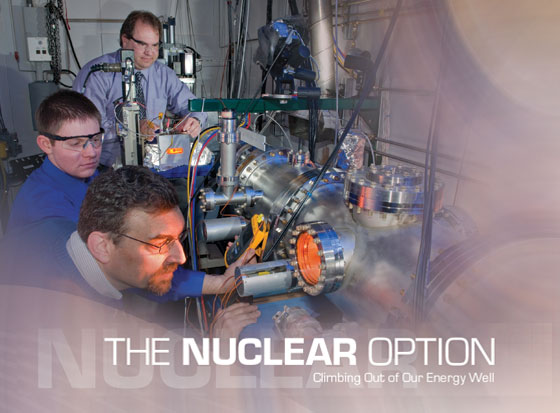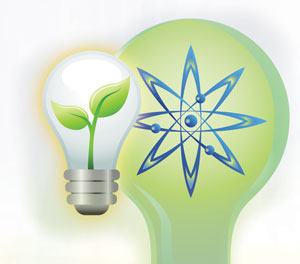
Jeff Terry [top], Dan Olive [middle], and Carlo Segre prepare a Zircaloy sample for corrosion studies using the Materials Research Collaborative Access Team beamline at Argonne National Laboratory. Zircaloy is an alloy used in the nuclear industry as a fuel cladding.
Jeff Terry, IIT assistant professor of physics, frets about the future of energy—probably more than most people. “I always think of that scene from the movie Apollo 13,” he says, describing the embattled spacecraft, which had begun filling up with lethal carbon dioxide. Back at mission control, someone declares, “Power is everything.” Even if all other problems are solved, the flight controller explains, without enough power to open the ’chutes on re-entry, the crew is dead.
In Terry’s view, that spacecraft is a metaphor for our planet, where reserves of non-renewable energy are being depleted rapidly.
Terry is a strong advocate for the revival of nuclear energy, which has been largely abandoned in the United States since the late 1970s. “I like to think that I’m a true environmentalist,” he says, without irony. He’s not alone in this view. Even some career environmentalists—including Scott Howson, chairman of the Rappahannock Group of the Sierra Club, Greenpeace co-founder Patrick Moore, and biologist James Lovelock—have spoken out in favor of nuclear development. The Intergovernmental Panel on Climate Change report of 2007 also gives a cautious nod to nuclear as a “commercially available climate change mitigating” technology. It’s tough to say they’re in love with the idea. But, to paraphrase Winston Churchill’s riff on democracy, nuclear may be the worst energy solution—except compared to all the others.
Though nuclear power remains a contentious subject, often linked by the public with disasters like Chernobyl and weapons proliferation, the world’s growing consumption of energy and increasing awareness of the environmental pitfalls of fossil fuel use are prompting a fresh examination.
Beam Me Up

Trained as a staff scientist at Los Alamos National Laboratory, Terry is an expert on the characterization of radioactive materials and has more than a decade of experience with synchrotron radiation research. In November 2008, he was recruited to run an ambitious new $20 million project known as the Nuclear and Radiological Research Collaborative Access Team, or NRR CAT, at Argonne National Laboratory’s Advanced Photon Source. Here, radioactive materials to be used in future nuclear reactors can be studied safely.
The work at NRR CAT will represent an important expansion of IIT’s longstanding involvement with synchrotron research. The Center for Synchrotron Radiation Research and Instrumentation came together at IIT in the early 1990s, spurred by the construction of the Advanced Photon Source. Situated just 25 miles southwest of Chicago, APS is the largest synchrotron X-ray source in the western hemisphere.
In addition to IIT core members, CSRRI leverages the talents of faculty-researchers university-wide and is involved in collaborations with scientists from around the world. The center is also a training ground for the next generation of nuclear specialists, offering academic coursework as well as training workshops at national and international conferences. The Graduate Assistantships in Areas of National Need Fellowship Program at IIT supports doctoral candidates in physics with a specialization in synchrotron radiation-based research.
The synchrotron radiation at Argonne begins with electrons, which are produced by a heated cathode and accelerated to 99.999 percent of the speed of light, using Argonne’s linear accelerator. The electrons are then fed into an oval-shaped booster synchrotron to speed them up even further before they are finally injected into the 1,104-meter storage ring, around which they whiz in circles, constrained in their paths by more than 1,000 powerful electromagnets. These speeding electrons produce X-ray beams as they accelerate, decelerate, or change direction. Ports located around the ring allow the streams of X-rays to be sampled and applied to research. The flood of X-rays produced by the APS range in intensity from a thousand to a million times those produced by traditional sources.
Such beamlines are used for varied investigations, from the study of semiconductors, magnetic materials, and nanostructures to large biological molecules and new energy technologies, including fuel cells. As Carlo Segre, IIT professor of physics and a member of CSRRI explains, a synchrotron can be thought of as an enormous microscope, able to probe materials at the atomic scale, due to the very short wavelengths of X-rays.
Material Witnesses
Synchrotron technology provides the opportunity to research and refine the materials used in nuclear reactors. “We’re interested, for example, in studying how you make a fuel pellet and encapsulate it so that the uranium and other radioactive materials don’t leak out,” Segre explains. He has also been working with colleagues from the University of Santa Barbara to develop oxygen dispersion strengthened steel, a specialized material containing nanoparticles that exhibits improved performance under radiation conditions. The Advanced Photon Source is an ideal tool to characterize the behavior and appearance of the nanoclusters. This hybrid form of steel could be used eventually to line reactor wall vessels, which must withstand strong irradiation by neutrons.
Dan Olive, an IIT graduate student working with Terry, studies how plutonium behaves in the environment, specifically, how it is able to form colloids—chemical mixtures in which particles are suspended. Olive’s work addresses nuclear energy’s greatest Achilles heel—the problem of radioactive waste. Much of his research is conducted for the U.S. Department of Energy Waste Isolation Pilot Plant, or WIPP, a storage facility for radioactive materials in Carlsbad, N.M., which has supplanted the Yucca Mountain site, defunded in 2009.
Over time, fission products that absorb neutrons during nuclear reactions build up in nuclear fuel, eventually halting the reaction. The fuel must then be removed, though as Terry points out, it still contains most of its energy. “It’s like throwing out the gas tank of your car when it’s still three-quarters full because there’s air inside of it,” he says.
Though the Salado salt formation, which lies 2,000 feet underground and extends from Kansas to New Mexico, and currently houses the WIPP, is sufficient to store all of the country’s nuclear waste for the foreseeable future, most experts agree that there must be a safe and effective means of reprocessing nuclear fuel, if we are to avoid running out of uranium.
“Reprocessing is really the way to go. Unfortunately, we’re not quite there yet,” Olive says. Such reprocessing involves the separation of neutron-absorbing waste byproducts from remaining fissionable material—the uranium or plutonium, which can then be used as reactor fuel. Critics of the procedure fear the diversion of resulting material, which could be used potentially for weapons.
According to Aleksandar Ostrogorsky, a new faculty member in IIT’s Department of Mechanical, Materials, and Aerospace Engineering, proliferation and other safety concerns are important considerations, but fears may be overblown. He points to a generally positive track record for reactors, noting that most U.S. water-cooled and moderated reactor designs—pressurized water reactors and boiling water reactors—are safer than the Russian graphite pile device involved in the Chernobyl disaster. As for the threat of proliferation, Ostrogorsky notes that a number of countries now have access to the Zippe-type centrifuges and the know-how for enriching uranium, or they could use plutonium produced in their own reactors without having to pilfer supplies from U.S. reactors.
Ostrogorsky, who worked in the field of nuclear engineering from 1977– 1982, is currently involved in research funded by the National Nuclear Security Administration (within the DOE) into a new generation of high-resolution gamma ray detectors that can keenly sense nuclear radiation. Such technology is widely applicable to many fields and may be used in future reactors for radiation monitoring.
Nuclear ABCS

In terms of environmental friendliness, nuclear energy is sandwiched between emission-free alternatives like solar and wind, and carbon-emitting technologies—including public enemy No. 1, the coal-fired power plant, which supplies the U.S. with more than 50 percent of its electricity but also is the leading source of mercury pollution and toxic particulates. The basic mode of power generation with each of these is the conversion of energy from one form into another. As Segre explains, both nuclear and conventional coal-fired plants rely on thermodynamic processes to heat water and use it to drive giant, magnetized turbines that generate electricity.
In the case of nuclear, the process works on the principle that very heavy elements like uranium are unstable. The uranium nucleus is held together by a specific energy, known as the binding energy, which is released in the form of gamma rays, neutrons, and kinetic energy when the nucleus is torn apart into more stable constituents.
Fission reactors use pellets of uranium, including the radioactive isotope U-235, encased in fuel rods. In the reactor’s core, fissionable uranium undergoes a controlled chain reaction, releasing energy in the form of heat, turning pressurized water into pressurized steam to drive the electricity-producing turbines. The advantage over a coal plant is that during actual operation, there are no toxic emissions or CO2 released from smokestacks (though some CO2 is involved in the mining of uranium ore, refining, and enriching fuel, and construction of the plant itself). The disadvantage is that spent fuel persists at the end of its cycle as a long-lasting hazardous waste that must either be stored or reprocessed.
Toward a Carbonless Future
The current energy picture is alarming. As Terry notes, fossil fuels today deliver 86 percent of our energy. Of the remaining 14 percent, roughly 40 percent is nuclear and about 20 percent is hydroelectric. Biomass is used much more widely than renewables like solar, geothermal, or wind power. “When we’re talking biomass,” Terry explains, “we mean people who are cutting down trees or plants and burning them to survive.”
Nuclear energy will not provide a panacea for the world’s energy woes.
At best, it will be a slice of the new energy portfolio, which seeks to offset nearly all of the world’s fossil fuels by mid-century, if goals set by the IPCC are to be met. Atmospheric CO2 must be driven down and held to below 350–450 parts per million. The alternative, we are warned, is continued warming of the planet, with unknown and potentially catastrophic consequences.
Given these sobering estimates, one may wonder why carbon-reducing platforms, including nuclear, are not at the forefront of the nation’s agenda. As chairman and chief executive officer of Exelon, owner of the country’s largest fleet of nuclear reactors, IIT Board of Trustees Chair John Rowe has been pondering these issues throughout a lengthy career. He emphasizes that despite the gathering awareness of our energy predicament, new reactors continue to face daunting economic and political hurdles.
For the past 30 years or so, nuclear construction has languished due to a combination of public resistance and exorbitant cost. In addition, bureaucratic tangles from siting to reactor design approval and licensing are formidable, requiring about a decade for completion of a new plant. Though there has been some movement on Capitol Hill of late, Rowe remains skeptical. “Unfortunately, at the present time the only thing that’s cheap is burning natural gas,” he says, adding that convincing, bipartisan commitment to nuclear energy has yet to materialize.
Rowe says the prospects for meeting some of the more ambitious goals, which call for 350,000 megawatts of additional, carbon-free electrical energy by 2030, are bleak. “It’s not going to happen,” he insists, noting that 50,000 megawatts of additional nuclear by 2030 might be feasible. In the first 10 years of nuclear redevelopment, only 8,000–10,000 megawatts are projected, based on the construction of four to eight new plants. Rowe says an essential first step is the passage of aggressive climate legislation with incentives for carbon-free energy coupled with some system of cap and trade to limit carbon emissions.
In the second half of the century solar will have to play a very large role, but presently solar is uneconomic, at least without massive subsidies. Exelon estimates place natural gas at roughly $10 a ton of avoided CO2, whereas new nuclear comes in at around $70 and wind varies from $50–80 per ton. Offsetting CO2 through sequestration or solar energy is even pricier. “I think it’s terribly important that the first four to eight plants get built,” Rowe stresses. “If they don’t, we’re not going to have a good base for building the 14 to 20 that we’ll need going into the next decade.”
In the wake of the December 2009 climate talks in Copenhagen, an increasing sense of urgency permeates discussion of our energy future. As demands for cleaner energy become ever more acute, the DOE hopes to expand its research base, with an eye toward maintaining existing nuclear facilities while paving the way for a new generation of reactors and safer means of disposing spent fuel. The NRR CAT project holds promise to be a valuable research element within the DOE’s developing energy plan. In the meantime, our daily energy consumption adds to the roughly 10 billion metric tons of carbon expelled into the atmosphere annually. According to the Energy Information Administration’s Annual Energy Outlook for 2008, America’s overall energy use is expected to grow by nearly 19 percent by 2030 while electricity demand alone is projected to climb by 30 percent during the same period. And every ton of CO2 released into the atmosphere lingers there for a century—some of it for thousands of years. Turning the carbon tide will be slow.
Time is the Enemy
A profound transformation in the way the world acquires and uses energy has barely begun. According to the IPCC’s 2007 report on climate change, world carbon output should ideally peak in just five years, before beginning a steep descent. The U.S. and other wealthy nations—the leading carbon polluters—need to slash carbon emissions 25–40 percent below 1990 levels by 2020, at a minimum. Added to the dilemma—rapid industrialization in the developing world and increasing population growth. “If we stay on this course and add another 4 billion people,” Olive warns, “then even if we turn off our electricity and the U.S. goes dark, it won’t matter.” Global management of CO2 is imperative, and new industrialization must be predicated on low carbon or carbon-free alternatives.
Today, concern for the environment—one of the very issues responsible for tabling nuclear energy three decades ago—may help drive the development of new reactors. It’s an irony not lost on those involved in the nuclear field, as attempts are made to address what some authorities on climate change call the greatest challenge our species has ever faced.
Research into the behavior of radioactive materials, such as the new work planned for NRR CAT, will begin laying the groundwork for a nuclear renaissance, when it comes. If it comes. Political and economic barriers are wed to many remaining technological trials. “No one has yet had a eureka moment,” Terry says, adding after a pause, “Boy, do we need one.”
More Online
Global campaign to reduce carbon: www.350.org/
Exelon's 2020 low-carbon roadmap: Exelon Plans
Technology behind nuclear reactors: science.howstuffworks.com/nuclear-power.htm